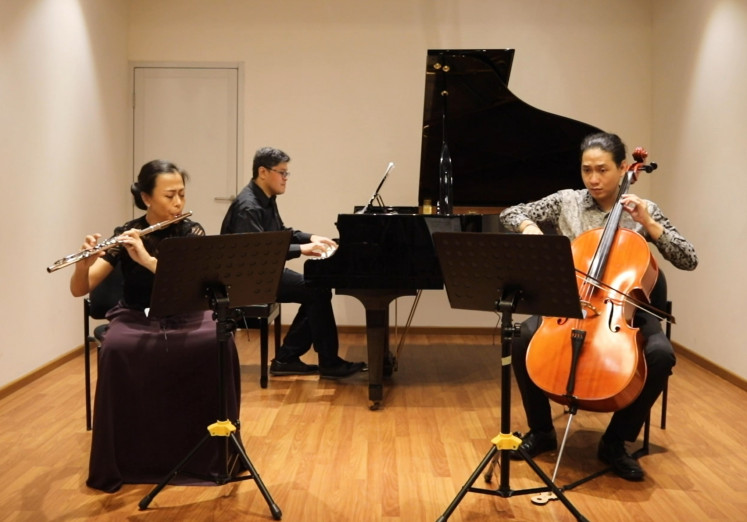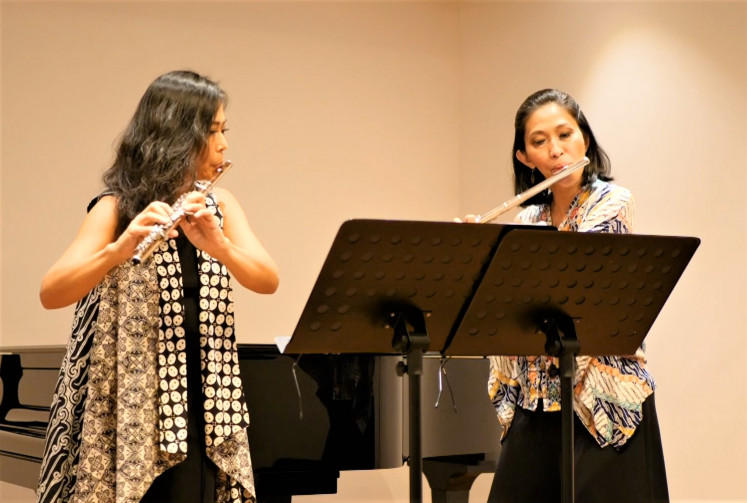Popular Reads
Top Results
Can't find what you're looking for?
View all search resultsPopular Reads
Top Results
Can't find what you're looking for?
View all search resultsConcerts chronicle the adventurous life of Beethoven
The Jakarta Conservatory of Music and Jakarta Sinfonietta went online to celebrate what would have been the 250th birthday of the seminal figure in world music.
Change text size
Gift Premium Articles
to Anyone
The world celebrated what would have been Beethoven's 250th birthday.
Many long-planned events were axed or improvised due to the pandemic.
But the two-day concerts held by the Jakarta Conservatory of Music and the Jakarta Sinfonietta were more than just an online impromptu event.
The concerts, held at the peak dates of the celebration on Dec. 16-17, 2020 and involved the conservatory’s lecturers and orchestra members, were organized in an intimate setup in which the musicians shared the backstory of the composition and even their personal accounts ahead of the performance.
Under the main theme “Happy Birthday, Ludwig!”, the Beethoven Online Festival allowed the paying audience to learn more about the seminal figure in world classical music starting from his youth.
Ludwig van Beethoven was baptized in Bonn, Germany, on Dec. 17, 1770. There is no official record of his birth date, but due to the custom of baptizing a one-day-old newborn, it is safe to assume he was born on the 16th.
Passing away in 1827, Beethoven had crafted a technique of using leitmotif – the recurrence of a few notes or a rhythmic gesture – to build an entire movement or a composition, producing iconic pieces.
His greatness, however, is not the only reason the composer is celebrated worldwide.
Reminiscent: The Jakarta Conservatory of Music and Jakarta Sinfonietta held a virtual concert in December 2020 to celebrate what would have been Beethoven's 250th anniversary. (Courtesy of JCoM/Jakarta Sinfonietta)According to Iswargia R. Sudarno, the director of the Jakarta Conservatory of Music (JCoM) and the patron of Jakarta Sinfonietta, Beethoven was among figures that supported the French Revolution.
Indeed, the works of the plebeian genius were often seen as heroic as they expressed the struggle against tyranny, victory, fate and hope – imbuing his perception of the world he was born into.
It was a world in turmoil that started with the French Enlightenment that raised the ideals of individual freedoms, followed by the American Revolution, and a bit over a decade later the storming of the Bastille in 1789.
The way Beethoven lived could also be seen as a reflection of his political stance.
“Unlike other composers of his time, he was never a musical courtier owned by the church or the wealthy aristocrats,” Iswargia said at the opening of the first-day concert titled “The Youthful Ludwig”.
“Beethoven was always a freelancer and the first to create music to his heart’s content, which then aroused other composers to trail his path until today.”
The dynamics of his composition was unparalleled in his time. If other composers wrote quiet parts completely separated from the loud parts, Beethoven’s passed rapidly from one to another.
“The Youthful Ludwig” was a testament to his mastery exuded just as strong in his less-known works.
The “Sonata for Piano Four-Hands in D Major, Op. 6”, performed by Ellen Tania and Lavinia Wibisono, showed the recurrence of the small motifs and the transitions from the melodious fragments to fast-pacing ones he wrote at 17.
At 21, Beethoven wrote his first composition without piano dedicated to his lawyer friend JM Degenhart titled “Allegro” and “Minuet for Two Flutes in G Major, WoO 26” the score of which was discovered posthumously.
Flute duo Marini Marnoto and Metta F. Ariono of the Jakflute Ensemble said they first performed the piece in public during the early years of their career 20 years ago.
“The composition has a personal meaning to us,” said Metta.
Reunion: Flutists Marini Marnoto (left) and Metta F. Ariono reenact their 20-year-old performance playing Beethoven's first composition without a piano during the 'The Youthful Ludwig' virtual concert. (Courtesy of JCoM/Jakarta Sinfonietta)Next was “Allegretto” for piano, “Violin & Cello in B-flat”, “WoO 39” performed by pianist Karina Novelia, Ali Hanapiyah on violin, and Anggelia Sande Lilingan on cello.
The composition was made during his summer vacation in what later became Czechoslovakia, a gift to his friend’s 10-year-old son Maximiliane Brentano to entice him to pursue studying music.
Beethoven also wrote “Rondo for Violin & Piano in G Major”, “WoO 41” likely a gift for Countess Josephine de Clary, who was also an amateur pianist.
The piece was performed by young pianist Billy Oswald Sidjaja and violinist Riz Ramadhan at the concert.
The composer also created another four-hand piano piece when he was 29 for his students in Vienna, Therese von Brunsvik and Josephine Deym, titled “Six Variations on Piano Four-Hands ‘Ich denke dein’, WoO 74”.
“Beethoven rarely created a four-hand piano composition and it was not widely published,” said Iswargia, who played the piano in a duet with Rubi Pertama.
The performance also featured counter-tenor singer Julius Firdaus.
The last composition presented at the concert was “Trio for Piano, Flute & Cello, WoO 37” by pianist Harimada Kusuma, flutist Marini Marnoto and cellist Ade Sinata.
Written by Beethoven when he was 15, it was originally composed for piano, flute and bassoon.
“I have a hard time playing the piano part,” said Harimada, adding that the piece was “unusual” as the young composer used his own version in writing the dynamic notes and articulations as well as the overlapping sounds of the piano with flute and bassoon in the score.
“The piece, however, shows the mature side of Beethoven as he started to use complicated ornaments that became his trademark,” Harimada argued.
The second concert on Dec. 17 featured pianists Carla Suharto, Celine A. Meirani, Hazim R. Suhadi, Adelaide Simbolon, and Nesca Alma; as well as violinist Rifki Adriansyah Arif, cellist Bryant Gozali, and counter-tenor singer Julius Firdaus.
Titled “The Respected Herr van Beethoven”, they performed Part 1 and Part 3 of the “Three Marches”, Op. 45; “Sonata for Piano & Violin in A Minor, Op. 23”; the song “Adelaide, Op. 46”; and the “Cello Sonata No. 3, Op. 69” -- the latter was the first ever to give piano and cello equal importance while usually string instruments playing the supporting role.
The concert was a not-so-gentle reminder that Beethoven was a revolutionary in every sense of the word, changing how people in his time listened through a symphony.
The online concert was an important venture that honored the liberating spirit that Beethoven epitomized in his life and his works by bringing them into the present time. (ste)












